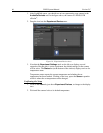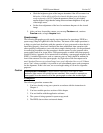
48 PIXIS System Manual Version 2.C
Check the brightest regions of the image to determine if the A/D converter is at
full-scale. A 16-bit A/D is at full scale when the brightest parts of the image
reach an intensity of 65535. Adjust the aperture to where it is just slightly
smaller (higher f-stop) than the setting where maximum brightness on any part
of the image occurs.
Set the focus adjustment of the lens for maximum sharpness in the viewed
image.
5. After you have focused the camera, you can stop Preview mode, continue
Preview mode, or begin Acquire mode.
Spectroscopy
The following paragraphs provide step-by-step instructions for operating a PIXIS in a
spectroscopy setup in LightField for the first time. The intent of this simple procedure is
to help you gain basic familiarity with the operation of your system and to show that it is
functioning properly. Once basic familiarity has been established, then operation with
other operating configurations, ones with more complex timing modes, can be performed.
An underlying assumption for the procedure is that the camera is to be operated with a
spectrograph (such as an Acton Series 2300 spectrograph) on which it has been properly
installed (refer to Appendix D for instructions for mounting a spectrograph adapter to the
PIXIS). A suitable light source, such as a mercury pen-ray lamp, should be mounted in
front of the entrance slit of the spectrograph. Any light source with line output can be
used. Standard fluorescent overhead lamps have good calibration lines as well. If there
are no "line" sources available, it is possible to use a broadband source such as tungsten
for the alignment. If this is the case, use a wavelength setting of 0.0 nm for alignment
purposes.
Overexposure Protection: Cameras that are exposed to room light or other
continuous light sources will quickly become saturated. If the camera is mounted to a
spectrograph, close the entrance slit of the spectrograph to reduce the incident light.
Assumptions
The following procedure assumes that
1. You have already set up your system in accordance with the instructions in
Chapter 4.
2. You have read the previous sections of this chapter.
3. You are familiar with the application software.
4. The system is being operated in spectroscopy mode.
5. The PIXIS does not have an internal shutter.
Caution


















